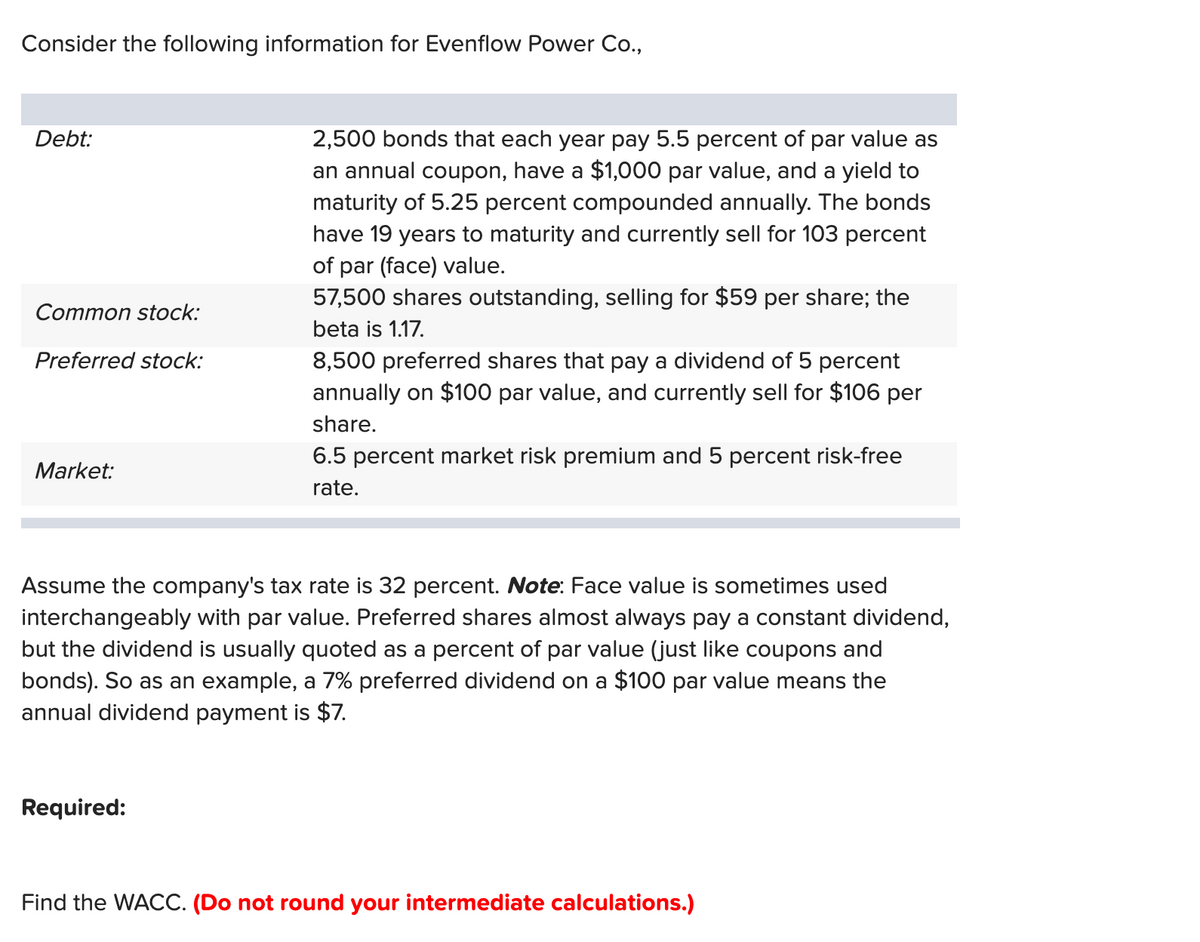Consider the following information for Evenflow Power Co., Debt: 2,500 bonds that each year pay 5.5 percent of par value as an annual coupon, have a $1,000 par value, and a yield to maturity of 5.25 percent compounded annually. The bonds have 19 years to maturity and currently sell for 103 percent of par (face) value. 57,500 shares outstanding, selling for $59 per share; the Common stock: beta is 1.17. Preferred stock: 8,500 preferred shares that pay a dividend of 5 percent annually on $100 par value, and currently sell for $106 per share. 6.5 percent market risk premium and 5 percent risk-free Market: rate. Assume the company's tax rate is 32 percent. Note: Face value is sometimes used interchangeably with par value. Preferred shares almost always pay a constant dividend, but the dividend is usually quoted as a percent of par value (just like coupons and bonds). So as an example, a 7% preferred dividend on a $100 par value means the annual dividend payment is $7. Required: Find the WACC. (Do not round your intermediate calculations.)
Consider the following information for Evenflow Power Co., Debt: 2,500 bonds that each year pay 5.5 percent of par value as an annual coupon, have a $1,000 par value, and a yield to maturity of 5.25 percent compounded annually. The bonds have 19 years to maturity and currently sell for 103 percent of par (face) value. 57,500 shares outstanding, selling for $59 per share; the Common stock: beta is 1.17. Preferred stock: 8,500 preferred shares that pay a dividend of 5 percent annually on $100 par value, and currently sell for $106 per share. 6.5 percent market risk premium and 5 percent risk-free Market: rate. Assume the company's tax rate is 32 percent. Note: Face value is sometimes used interchangeably with par value. Preferred shares almost always pay a constant dividend, but the dividend is usually quoted as a percent of par value (just like coupons and bonds). So as an example, a 7% preferred dividend on a $100 par value means the annual dividend payment is $7. Required: Find the WACC. (Do not round your intermediate calculations.)
Chapter20: Financing With Derivatives
Section: Chapter Questions
Problem 17P
Related questions
Question

Transcribed Image Text:Consider the following information for Evenflow Power Co.,
Debt:
2,500 bonds that each year pay 5.5 percent of par value as
an annual coupon, have a $1,000 par value, and a yield to
maturity of 5.25 percent compounded annually. The bonds
have 19 years to maturity and currently sell for 103 percent
of par (face) value.
57,500 shares outstanding, selling for $59 per share; the
Common stock:
beta is 1.17.
Preferred stock:
8,500 preferred shares that pay a dividend of 5 percent
annually on $100 par value, and currently sell for $106 per
share.
6.5 percent market risk premium and 5 percent risk-free
Market:
rate.
Assume the company's tax rate is 32 percent. Note: Face value is sometimes used
interchangeably with par value. Preferred shares almost always pay a constant dividend,
but the dividend is usually quoted as a percent of par value (just like coupons and
bonds). So as an example, a 7% preferred dividend on a $100 par value means the
annual dividend payment is $7.
Required:
Find the WACC. (Do not round your intermediate calculations.)
Expert Solution
This question has been solved!
Explore an expertly crafted, step-by-step solution for a thorough understanding of key concepts.
This is a popular solution!
Trending now
This is a popular solution!
Step by step
Solved in 3 steps with 5 images

Knowledge Booster
Learn more about
Need a deep-dive on the concept behind this application? Look no further. Learn more about this topic, finance and related others by exploring similar questions and additional content below.Recommended textbooks for you

EBK CONTEMPORARY FINANCIAL MANAGEMENT
Finance
ISBN:
9781337514835
Author:
MOYER
Publisher:
CENGAGE LEARNING - CONSIGNMENT


Intermediate Financial Management (MindTap Course…
Finance
ISBN:
9781337395083
Author:
Eugene F. Brigham, Phillip R. Daves
Publisher:
Cengage Learning

EBK CONTEMPORARY FINANCIAL MANAGEMENT
Finance
ISBN:
9781337514835
Author:
MOYER
Publisher:
CENGAGE LEARNING - CONSIGNMENT


Intermediate Financial Management (MindTap Course…
Finance
ISBN:
9781337395083
Author:
Eugene F. Brigham, Phillip R. Daves
Publisher:
Cengage Learning

Principles of Accounting Volume 1
Accounting
ISBN:
9781947172685
Author:
OpenStax
Publisher:
OpenStax College